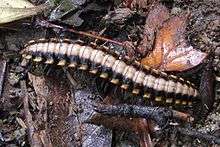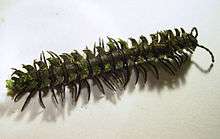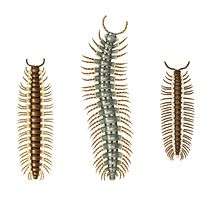Platyrhacidae
Platyrhacidae is a family of polydesmidan millipedes distributed in Southeast Asia and tropical Central and South America.
| Platyrhacidae | |
|---|---|
 | |
| Nyssodesmus python from Central America | |
| Scientific classification | |
| Kingdom: | |
| Phylum: | |
| Subphylum: | |
| Class: | |
| Order: | |
| Suborder: | |
| Family: | Platyrhacidae Pocock, 1895 |
| Genera | |
|
c. 50 [1] | |
| Synonyms | |
|
Platyrrhacidae | |
Description
Platyrhacids are often large and colorful. They can be distinguished from most other polydesmidans by having ozopores situated further inward from the paranota margins, ozopores surrounded by a broad, flat ring, and presence of compound setae on the labrum and often on the epiproct (a posterior extension of the telson). The gonopods in males are relatively simple, although up to five gonopodal processes ("branches") may be present in some genera from Borneo.[2][3] Large platyrhacids in Borneo may grow up to 13 cm (5.1 in) long and exhibit colors of blue, green, and yellow with black spots or stripes.[4]
Distribution
Platyrhacids occur in two disjunct geographic areas. The majority of species occur in Southeast Asia, including the Greater Sunda Islands and the Philippine archipelago. The rest occur in the New World Tropics from Nicaragua to Peru, as well as on some Caribbean islands.[3][5]
Classification
The Platyrhacidae is part of the larger suborder Chelodesmidea. The family Platyrhacidae is subdivided into several groups, formerly considered tribes but elevated to the status of subfamilies in 2013.[5]


- Barydesminae - Neotropical America
- Barydesmus
- Nyssodesmus
- Tyrodesmus
- Diodontodesminae - Solomon Islands
- Diodontodesmus
- Erythrhacinae
- Hoplurorhachinae - Borneo
- Phyodesminae- Borneo
- Phyodesmus
- Polydesmorhachinae -Palawan island, Philippines
- Psammodesminae - Neotropical America
- Psaphodesminae - Indonesia, east of Wallace's line
- Taphodesminae
- Taphodesmus
- Unplaced
The following genera have not yet been placed into a subfamily[5]
- Hoffmanorhacus
- Nanorrhacus
- Proaspis
Classification history
The family (originally misspelled "Platyrrhacidae") was named by Reginald Pocock in 1895 to include the single genus Platyrhacus. Shortly after, Orator F. Cook added Acanthodesmus, Odontodesmus, and Trachelodesmus. By 1897, additional works by Cook, Pocock, and Filippo Silvestri had increased the number of genera to 37.
The North American genera Euryurus, Auturus, and Illiniurus, were long-considered to constitute a sub-group of Platyrhacidae (i.e. the subfamily Euryurinae or tribe Euryurini in various classifications), until separated as a distinct family (Euryuridae) by Hoffman in 1998 and allied closer to Xystodesmidae. Similarly and concurrently, several neotropical genera previously placed in other subgroups of Platyrhacidae were removed and elevated to full family status: the Aphelidesmidae.[2]
References
- "Platyrhacidae". Catalogue of Life. 30 May 2014.
- Hoffman, Ricahard L. (1998). "Reassessment of the Platyrhacidae, a family of polydesmidan millipeds" (PDF). Myriapodologica. 5 (13): 125–141.
- Hoffman, Richard L. (2001). "A synopsis of the platyrhacid millipeds of Borneo (Diplopoda: Polydesmida: Platyrhacidae)". Revue Suisse de Zoologie. 108 (2): 403–440.
- Hoffman, Richard L. (1978). "Synopsis of the milliped genus Phyodesmus (Polydesmida: Platyrhacidae)". Journal of Natural History. 12 (3): 245–257. doi:10.1080/00222937800770141.
- Shelley, Rowland M.; Martinez-Torres, Daniela (2013). "The milliped family Platyrhacidae (Polydesmida: Leptodesmidea) in the West Indies: Proposal of Hoffmanorhacus n. gen.; description and illustrations of males of Proaspis aitia Loomis, 1941; redescription of Nannorrhacus luciae (Pocock, 1894); hypotheses on origins and affinities; and an updated New World familial distribution". Zootaxa. 3626 (4): 477. doi:10.11646/zootaxa.3626.4.4.